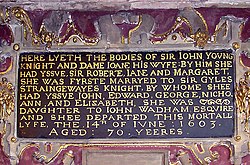Monumental script

A monumental or monumental script is an inscription that is placed on gravestones , cenotaphs , memorial plaques or other monuments .
Monumental inscriptions often serve to commemorate the deceased . On gravestones, it is usually up to family members to determine their form and content, while memorial plaques in religious institutions usually come from a larger community.
Monumental inscriptions are an important source for genealogists as they provide information about life and death including dates. Occasionally, family relationships can also be determined, as close relatives were not infrequently buried together. War memorials usually only contain lists of names, since the date of death and the exact burial place of the people who fell in the war zone are mostly unknown. The place of installation can, however, provide information about the home parish.
Since many old gravestones become illegible over time due to weathering , genealogical associations try to publish their inscriptions in book form, on microfilm or, more recently, on the Internet and thus make them accessible to a wider public.